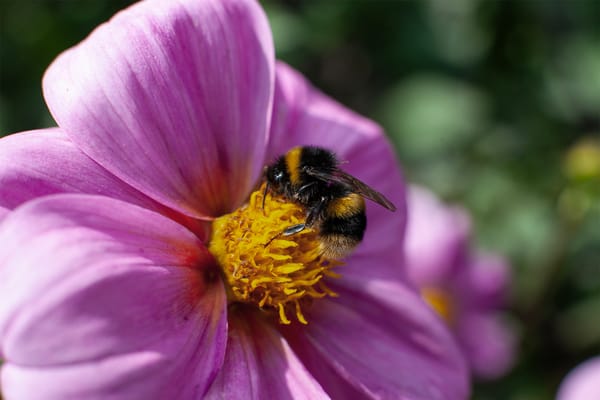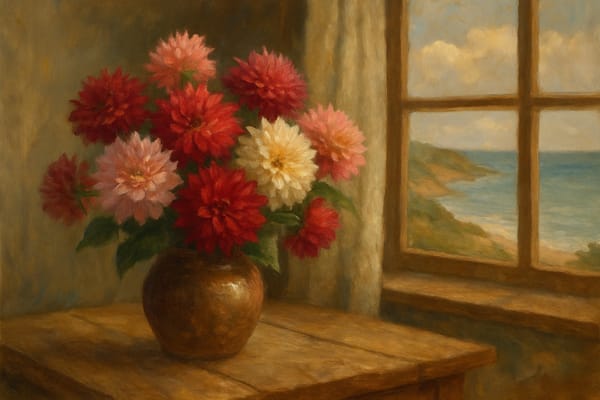Dahlias are beloved for their dazzling displays—but not all are created equal when it comes to supporting garden wildlife. Behind the riot of colours lies a simple truth: the flower’s form determines whether it’s merely ornamental or a vital resource for pollinators.
In Cornwall’s windswept gardens and beyond, choosing the right dahlias can transform a border from a private spectacle into a living, buzzing haven for bees, butterflies, and beneficial insects. Here’s how thoughtful planting choices make the difference—and how you can weave dahlias into a wildlife-friendly tapestry.
Open Blooms: The Pollinator’s Choice
Dahlias with single or open flowers reveal their golden hearts of pollen and nectar—nature’s open invitation to pollinators. These varieties aren’t just decorative; they are indispensable waystations for bees, hoverflies, and butterflies on their seasonal circuits.
- ‘Bishop of Llandaff’ — With its vivid red petals and dark foliage, this single-flowered classic hums with bee activity from midsummer to autumn.
- ‘Happy Single’ Series — Cheerful, long-flowering singles in shades from coral to cream, perfect for wildlife borders and pots alike.
- Dahlia merckii — A species beloved for its simple lilac flowers and airy habit, often self-seeding to create natural drifts alive with pollinator visits.
The single’s charm is more than surface deep—it’s ecological. By providing easy access to nectar and pollen, these dahlias earn their keep in any wildlife-focused planting scheme.
The Double Dilemma: Beautiful but Barren?
Lush, multi-petalled doubles—dinnerplates, decorative types, and pompoms—steal the show with their form but hide their pollen in a maze of petals, often out of reach for insects. While perfect for exhibitions and dramatic borders, they offer little to wildlife.
Does this mean you should avoid them entirely? Not at all. Used sparingly among singles and wildlife-friendly companions, doubles can lend impact without starving the local ecosystem.
Designing a Wildlife-Friendly Dahlia Border
Crafting a border that balances beauty and biodiversity is an art. Here’s a simple layered plan that works in Cornish gardens and further afield:
| Layer | Planting Suggestions | Wildlife Role |
|---|
| Back | Tall singles like ‘Bishop of Llandaff’, Verbena bonariensis | High nectar access, structure |
| Middle | Mixed single/semi-double dahlias, Helenium, Cosmos | Dense nectar/pollen sources |
| Front | Dwarf singles like ‘Happy Single’, low asters, Nepeta | Ground-level forage for bees |
| Edge | Alchemilla mollis, thyme, calendula | Shelter, early nectar |
Add ornamental grasses like Stipa tenuissima or Molinia for movement and insect refuge, and you have a dynamic, multi-purpose planting scheme.
The Coastal Connection: Pollinators by the Sea
In Cornwall’s coastal gardens, pollinator planting often overlaps with practical resilience. Open-flowered dahlias thrive in breezy spots where tougher doubles may snap or fail. Planting in well-drained soil, mulched to protect against salt spray, gives both your dahlias and visiting insects the best start.
Companions like sea holly (Eryngium), wild carrot (Daucus carota), and native clovers add forage and fortify the pollinator corridor along coastal plots.
Wildlife Gardening in Action: Beyond the Flowers
- Pesticide-Free Zones — Avoid systemic pesticides and broad-spectrum insecticides that harm beneficial insects.
- Seedheads for Birds — Leave some faded blooms to set seed; finches and sparrows will reward you in autumn.
- Succession Planting — Interplant early bloomers like alliums and crocus for spring forage, with late stars like asters and rudbeckia for autumn.
In Every Bloom, a Chance to Support Life
Dahlias offer the rare chance to marry gardener’s passion with nature’s need. By blending singles, collarettes, and pollinator-friendly companions, you’ll create a garden that hums with life—and still stops visitors in their tracks.
In the end, a border alive with bees and butterflies isn’t just a joy for the eye—it’s a living thread in the tapestry of Cornwall’s wild beauty and the greater natural world.











